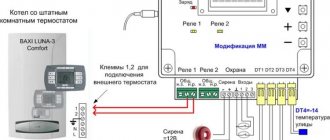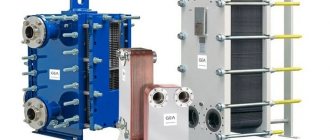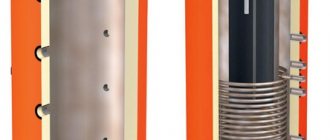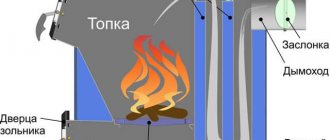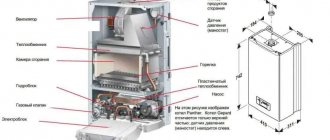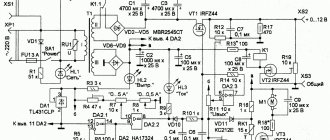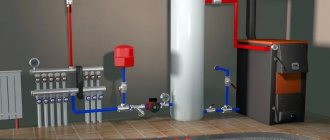How does a heat exchanger work?
A heat exchanger, or radiator, is designed to heat water from the burner.
The flow flows through the coil tubes, instantly warming up from the burning fuel. Most often the block is steel or copper. How much does the device weigh? Copper device - from 3 to 3.5 kg. The steel apparatus is much heavier, for this reason it has lower efficiency. Features of steel product:
- Lower cost compared to copper.
- Due to the plasticity of the material, heating does not harm the surface.
- It is resistant to corrosion.
Copper device:
- It has high efficiency and fast heating.
- Products that contain additional impurities are cheaper.
- Corrosion resistance.
- Light weight if it is pure copper.
Trying to reduce the cost of production, manufacturing companies add impurities to copper. Because of this, the radiator heats up unevenly, which leads to burnout of individual parts. Some people coat the surface with heat-resistant paint, but this brings little results. The service life does not exceed 2-3 years.
Copper is more resistant to corrosion than steel. Most manufacturers do not indicate how much copper is used to produce the product, convincing them that the heat exchanger is made of a thick layer.
To extend the life of the device, install water filters. They soften and clean the liquid from impurities that settle on parts in the form of scale.
How much does it cost to replace a gas boiler radiator? If you take into account the purchase of a new device, delivery and installation, it will be cheaper to repair the heat exchanger.
Popular manufacturers
Cast iron heat exchanger for Beleto floor-standing boiler
Heat exchangers are produced by many manufacturers. The most popular companies in 2022 were the following.
Navien
The largest Korean manufacturer. It produces products intended for household boilers. The advantage is resistance to low water quality and water hammer. The device is perfectly adapted to poor operating conditions.
Baxi
Italian manufacturer. Presents on the market wall-mounted and floor-mounted condensing boilers with a cast iron heat exchanger, as well as electric heaters.
The company makes primary heat exchangers from copper and brass. For secondary plates, stainless steel is used. This increases the cost of the products, but ensures maximum durability.
And others
There are other worthy manufacturers on the market:
- Fondital Victoria Compact is an Italian company. Offers high performance bithermic copper heat exchangers.
- Beleto is a well-known Russian plant that produces a variety of gas equipment. Manufactures steel, cast iron and copper heat exchangers of various types.
- Ariston - offers aluminum and copper heat exchangers. The materials are insensitive to corrosion, and the manufacturing technology guarantees their strength.
If there is a need to increase the efficiency of the boiler when replacing the device, consult a specialist to calculate the required parameters.
Classification of heat exchangers for boilers
Heat exchange elements for a gas boiler can differ significantly in design and use. The following devices are most often used in thermal equipment:
Primary
This category of devices is used to transfer thermal energy directly into the fuel combustion chamber.
Attention ! Primary heat exchangers are operated in very harsh conditions, so they must be made of very high quality materials.
Secondary
The secondary heat exchanger is heated by transferring energy from the coolant to another liquid.
This device is ideal for meeting the need for hot water in the presence of a separate heating circuit.
Bithermal
A bithermic heat exchanger is a modern and practical element of a heating boiler.
This design consists of 2 separate tubes installed one inside the other. Products of this type are used primarily for simultaneous heating of water for heating and domestic needs.
Purpose of the boiler heat exchanger
A heat exchanger is a basic operational component of boiler equipment that transfers heat received as a result of the combustion of main gaseous fuel. It is located near the burner device.
The walls of the device are made of metal with a good heat transfer coefficient. The coolant liquid washes the heating surface of the heat exchanger, heats up to a temperature of 65-95 C and enters the intra-house heating network.
The movement of the coolant to the heating radiators occurs naturally, due to the temperature difference between the heated and cooled coolant, or in a forced way, using a centrifugal pump. Passing through the heating system, the cooled coolant returns to the boiler for the next heating cycle
In modern energy-efficient boilers, plate designs are the most common. In them, stainless steel plates are securely soldered to each other at the points of contact and along the edges.
This 100% guarantees tight operation, without leakage or mixing of liquids from different heating circuits.
The preferred material for soldering in such structures is copper. The design prevents scale formation and corrosion on the heating surface of the boiler. This ensures economical operation of the boiler unit with high efficiency.
Material of manufacture
The heat exchanger for the boiler is made from durable materials that conduct heat well, are not prone to corrosion and are sufficiently resistant to pressure. Since the cost of the material also has to be taken into account, the choice is limited.
Steel
A steel heat exchanger is cheaper in price, but less durable.
This is the most affordable material. Steel is very strong, but can be processed well. The price is low. The advantage of this option is resistance to high temperatures. Steel is plastic and does not crack when heated, and does not deform even in areas in contact with the burner.
A steel heat exchanger for a solid fuel or gas boiler is prone to corrosion. Water inside the tubes and combustion products in the boiler chamber have a destructive effect on the material. This affects durability. The steel model weighs a lot, which leads to additional fuel consumption for heating the element itself.
The stainless steel heat exchanger is resistant to corrosion and lasts for at least 50 years.
Cast iron
The material is much more resistant to corrosion than steel, and is not afraid of rust and the action of acid anhydrides. The service life reaches 50 years. However, cast iron is a brittle alloy and can crack under the influence of temperature. To avoid damage, the cast iron tubular heat exchanger must be washed: if ordinary water is used, then once a year; if antifreeze - then once every 2 years; if distilled liquid - once every 4 years.
The weight of a cast iron element is even greater, so more fuel and time have to be spent on heating.
Copper
Copper is a noble metal that is not susceptible to any type of corrosion. It is chemically inert and tolerates pressure well. Copper conducts heat better, so less fuel is required to heat the element itself and the flowing liquid. The weight of the copper model is small, the dimensions are compact with a very developed working surface.
The disadvantage is the high price. Also, the copper heat exchanger is too sensitive to heating to high temperatures. More often found in boilers from foreign manufacturers.
Criterias of choice
The main parameter of a heat exchanger is its power.
When choosing a device, the purpose is taken into account - in this case it is heating the coolant, and the type of medium - steam, water, antifreeze. A gas boiler usually works with water, but there are exceptions.
Other selection criteria:
- Coolant temperature at the inlet and outlet - it is necessary to calculate how much heat the consumer should receive. Based on these data, the heat exchanger power is calculated.
- Allowable pressure losses - the water pressure decreases as it passes through the heat exchanger. If it falls too low, it will not be possible to create a column of hot water of sufficient height.
- The maximum operating temperature on the burner reaches 600–700 C. A cast iron and steel heat exchanger can withstand this temperature; copper heat exchangers can withstand this temperature with some difficulty. The aluminum model must not be used.
- Maximum operating pressure – does not limit the choice of design or material.
Dimensions are a significant parameter. With the same efficiency, a shell-and-tube heat exchanger occupies an area 3–4 times larger than a plate heat exchanger.
Correct operation
The heat exchanger is washed depending on the water hardness.
Transportation, installation and operation of the heat exchanger device are described in detail in the instructions:
- The heat exchanger is placed in the apparatus so that it has easy access for inspection and repair.
- Start-up is performed at stable pressure and temperature. Do not increase the temperature faster than 10 degrees per minute or increase the pressure more than 10 bar per hour.
- When filled with water, the air valves and valves behind the heat exchanger remain open. After the pump starts, they are closed. In this way, stable pressure is achieved.
- You need to change the heating parameters smoothly. The slower this happens, the longer the seals and the heat exchanger itself will last.
- The device needs to be cleaned periodically. The plate is cleaned directly in the frame, then the plates are removed and washed. Another method is possible: first removing and then cleaning the plates. It is not recommended to clean shell-and-tube machines. In case of complex blockages, the technician installs a plug.
- Before restarting, check the condition of all gaskets. Pressure and temperature are set as at 1st start.
To avoid salt deposits, a filter is placed on the water pipe in front of the boiler entrance.
Connecting a floor-standing boiler
Installing a heating system and connecting a gas boiler yourself is very difficult. In most cases, such work is entrusted to professionals.
There are many companies that have the appropriate qualifications.
The work is carried out in several stages:
- Preparation of documents. First of all, they contact the gas service to find out the possibility of installing gas equipment in the house. There they receive technical conditions, according to which the project is ordered. The project prescribes diagrams for laying a gas main in the room and connecting equipment.
- Preparing the installation site. Floor-standing boilers are installed on a special base, in a ventilated room, at a certain distance from the walls and ceiling. If necessary, install a chimney.
- Installation, connection and configuration of gas equipment.
- Installation and connection of pipelines and heating radiators.
- Filling the system with coolant.
- Test run of the heating system.
Primary heat exchanger repair
The exchanger deteriorates due to poor quality coolant or the materials from which it is made, as well as other factors. Pressure, high temperatures and their differences lead to cracks, which is why the element begins to work less powerfully and breaks down over time. The life of the heat exchanger can be extended if purified water is supplied and the boiler is not overloaded.
We recommend: Insulating walls from the inside (inside) of a house or apartment with your own hands
It will be more difficult to eliminate cracks than clogs. The heat exchanger is soldered for this purpose. Select solder from the same material as the unit itself. Boiler heat exchangers are usually made of copper, less often cast iron or steel. Aluminum, silicon, manganese, nickel and zinc are added to the composition.
Leaks on the primary heat exchanger can occur due to exposure to flames, water hammer, and in some cases they are caused by corrosion
Additional solder requirements:
- melting point not lower than 700 °C;
- sufficient viscosity;
- fluidity is the same as that of a heat exchanger.
Copper-zinc solders are considered one of the best. They are used for soldering most non-ferrous metals with a higher melting point than the support material itself. Solders with inclusions of silicon or tin - up to half a percent - are safer for the human body.
It is better to avoid copper-phosphorus materials, and if exchangers are soldered with them, do so without any load such as shock or vibration. Well-chosen solder is half the battle.
Heat exchangers are soldered with gas burners and blowtorches. Before soldering, the desired area is cleaned with fine-grained sandpaper and wiped with a rag with a solvent, and then heated. The area is heated with a hairdryer or a weak burner/soldering iron. At this moment, the main thing is to get into the temperature corridor and take into account subsequent cooling. Barely noticeable damage is found by small greenish spots.
Before heating, the water is drained, and its remains are removed with a compressor or blown out through a flexible hose. The hose is fixed by thread if it has a union nut and the design features allow this. If you leave water, it will take away part of the thermal energy.
Solder spools: At high temperatures, the material wets the base and spreads across it, gets into the smallest gaps and stretches, resulting in an intermediate layer of base and solder combination
Solder is preferred in the form of a wire or rod: when soldering, the molten end will be well immersed in the flux, which will stick to it. If the wire lays on the exchanger itself too intermittently or loosely, the preheating was weak. After work, the soldering area is sometimes coated with heat-resistant paint for better insulation.
Over the next two weeks, the soldered area is checked daily for integrity. At the first detected leak, you should contact a specialist. If it appears in the first fortnight, it means the soldering was of poor quality.
The flux is suitable for universal use, as well as gel soldering flux. Avoid rosin, unusual options like aspirin and others.
Methods for igniting a double-circuit boiler
Without an automatic ignition system, few people imagine the comfortable use of gas heating equipment. There are two completely different principles that can be used for both electrically dependent and completely autonomous boilers - electric and piezo ignition.
The automation unit for piezo ignition of a double-circuit gas boiler has a simple design and resembles the device of a gas lighter (+)
The piezo ignition method operates on the same principle as ignition in a lighter - pressing a button causes a spark to appear, which starts the combustion process. In the future, control to ensure that the flame does not go out is carried out using a thermocouple.
The element is heated by the burner, generating a current that keeps the solenoid valve from slamming. During a temporary suspension, the wick still remains burning in the boiler.
Piezo ignition is often used in non-volatile boilers and is, in fact, a semi-automatic system. If the gas is turned off, the burner goes out and the valve closes, stopping further gas supply. You can restart the boiler by pressing the button.
Electric ignition provides complete automation - the heating device starts with the appearance of a spark, and the flame is controlled using an ionization control unit. When the power goes out, the automatic system is activated, it shuts off the gas, and when turned on, it starts the boiler.
In such devices there is no need for a constantly burning ignition filter, and this is a significant gas saving. You can eliminate the dependence of a boiler with electric ignition on the power supply using batteries.
Repair of secondary heat exchanger
Secondary heaters often clog, especially models with narrow channels. Without cleaning, they break down over time and finally fail. A layer of scale inside the unit reduces heat transfer, causing the boiler to consume more gas.
Salt deposits, scale and rust form the bulk of the contamination: in addition to the secondary heat exchanger, it doesn’t hurt to also check the heating and hot water circuits
Problems with heat exchangers will be indicated by codes on the boiler display. There is an action plan for this case.
Let's take a closer look at the problem with the secondary heater:
- We take out the secondary heat exchanger.
- We look at the joints, internal and external threads. After the last cleaning, their condition may have worsened. This happens due to aggressive acids. We replace worn out removable elements.
- We check the integrity. The heat exchanger could experience a water hammer. Only a specialist will find a very small fistula (hole).
- We better inspect the exchanger, and for this we call a specialist. We replace a severely damaged unit.
- Even at the very beginning, contamination can be found. We look for plaque visually in the inlet openings. We blow air into the part and also focus on the sound. We clean it if the exchanger is clogged. Pieces of scale may fall out of it even after a slight knock.
- You need to choose 1 of 3 cleaning options: home remedies like detergents and solutions with citric acid, special mixtures, or professional cleaning.
First of all, rinse the exchanger with a stream of water from a cold tap. Then pour citric acid into the device and place it in a bucket of water. Afterwards, take out the heat exchanger and pour water into it to check the permeability.
If it comes in slowly or does not move, then prepare a saturated solution of vinegar in water and pour it there. Then rinse with hot water and blow off. If possible, use an air pump. Do several cycles with vinegar.
Among the arguments for professional cleaning, it is worth noting the inconvenience of the design for cleaning, difficulties in assessing contamination, and the risk of damage due to independent mechanical action
If the steps described do not help, try special cleaning solutions: cleaning gel or low-percentage adipic acid solution. If this method does not work, then call a specialist or order professional cleaning.
Classification, principle of operation
There are two media in a gas boiler - gas and liquid. To transfer the air temperature obtained during gas combustion to the coolant, a heat exchanger is used. There are:
- primary;
- secondary;
- biothermal (combined).
Primary
Primary - heat exchangers that receive heat from a source. Included in the heating circuit. They are located in the boiler above the gas nozzles (a coil covered with plates). The coolant, usually water, passes through the tubes. Hot gases passing through plates and tubes heat the water. It is driven through the pump and goes into the heating. Gases are removed through the chimney.
Primary maintenance
Secondary
Secondary heat exchangers receive heat from the heated coolant. They are located outside the combustion chamber. Heating comes from the liquid. The simplest and most commonly used method is to use a plate heat exchanger. The sealed housing is divided into two parts by a thin partition. Heated liquid flows on one side of the partition, and water takes up heat on the other.
Sectional view of secondary plate heat exchanger
There is another way. A coil passes through a large container filled with water. A heated coolant passes through it, giving off heat to the surrounding fluid.
Combined (biothermal)
Installed inside the firebox. Has four pipes. One pair is connected to the heating circuit, the other to the DHW (hot water supply).
Biothermal heat exchanger
The difference is within the design. The heating circuit is heated by hot gases, the hot water supply circuit is heated by the heating gas. Inside the coil tubes there are tubes of smaller diameter. They are fastened with plates located at an angle of 120 or 90⁰.
Cut tubes, slots for contours
During operation of the boiler, the liquid in the primary circuit (heating) heats up and goes into the system. Previously, part of the heat is transferred to the tubes of the second DHW circuit, where the coolant is also heated.
Differences between a biothermal circuit and one with two separate heat exchangers
When water is drawn from the second circuit, the first circuit is closed so that the heat received from the boiler is transferred to the hot water supply. When the collection of water from the hot water supply stops, the first circuit is connected and the heating starts working.
Schemes in two modes
Disturbances in the operation of the column and their elimination
If your water heater suddenly leaks, sometimes the reason is worn out gaskets. When removing the casing, it becomes clear whether this assumption was justified. Having found a fistula in the heat exchanger, many consumers are interested in how to replace the problematic part. But the difficulty is that the price of spare parts reaches 30% of the price for a completely new heater.
It is much more practical to solder a mechanical defect using a soldering iron. Solder melts at about 200 degrees. The exact value is determined by the brand of the specific part. Even if the water boils for a long time, it will not damage the integrity of the “patch.” This solution is equally relevant for Russian and foreign speakers. After all, the risk of breakdown is present everywhere, only the service life differs, but defects will still appear in any model.
Specifics of operation of boilers with two circuits
Those who think that both circuits in such a system heat up at the same time are mistaken; in fact, everything works completely differently. In normal operation, such equipment operates on an ongoing basis only to heat the coolant circulating in the system. How often it turns on and how intense the flame appears during operation depends on the temperature sensor that monitors these processes. The pump starts together with the burner, but only when the natural circulation of the coolant does not have any impact on the operation of the heating system. After the temperature of the latter reaches the desired level, a signal is sent from the sensor that the burner activity should be reduced. Afterwards, the boiler operates only in passive mode until the temperature reaches the programmed level. Next, the sensor sends a signal to the automation, which, in turn, starts the valve responsible for supplying fuel.
It is enough to first familiarize yourself with certain subtleties of the functioning of gas boilers equipped with two circuits in order to understand what benefits can be obtained from their operation. Moreover, the purchase of such heating systems allows you to avoid purchasing additional equipment that may be required in any other case in order to provide the house with hot water. Even if one circuit fails, the second can continue to be used; replacing one circuit will still cost much less than repairing an entire heating installation.
A double-circuit boiler can be used in the summer, when there is no need for heating and all that is required is to provide heating of water intended for domestic needs. In this way, you can really save money, since purchasing two units at the same time, each of which functions autonomously, will cost much more.
Reasons for heat exchanger failure
The period of operation is determined primarily by how the water in the city water supply is disinfected. In Russia, either pure chlorine or chlorine dioxide is used. When the water flowing through the copper tube heats up, it causes a violent chemical reaction. Copper chloride is inferior to pure metal in strength, and therefore fistulas appear quite quickly. The luckiest people are residents of cities where tap water is ozonated.
We recommend: Ventilation for a gas boiler in a private house: requirements for the system, its types, power calculation and installation
But there are still very few such settlements. The high cost of the modern solution does not allow us to count on the rapid spread of ozonation. Moreover, now manufacturers have begun to save in every possible way. And if previously troubles happened quite rarely with thick tubes of heat exchangers, now thin, low-quality copper is used everywhere. The service life of products has significantly decreased.
Hydraulic group materials
The hydraulic group of the boiler is almost always located at the very bottom. There is a supply and return part of the boiler. The reverse part is where the pump is located. The hydraulic group can be made of brass. Now it is used less and less. Composite versions of the hydraulic group have begun to be used more often. This is ordinary heat-resistant black plastic. It can be seen in many boilers, it is used in many models, that is, there is a gradual transition to a more affordable material. There is nothing wrong with a plastic hydraulic group: it is cheap as a spare part, lasts a long time and runs. It happens, of course, that the connections in the plastic hydraulic group dry out and begin to leak. But this is not a problem: they can be easily disassembled and reassembled using flax and plumbing thread.
Baxi luna 3 gas boiler with brass hydraulic group
If you see a brass hydraulic group in a wall-mounted gas boiler, it means the manufacturer has decided not to save money and do everything very reliably. To this day this is the best solution. For something to happen to brass, you have to try. In addition, brass can always be restored and repaired. However, brass can be destroyed by the aggressive coolant environment. But for such an environment to exist, you need to be as negligent as possible about your heating system in a private home. Therefore, the brass hydraulic group still has priority.
composite hydraulic group. Boiler Baxi Eco 4s
The process of replacing a heat exchanger with your own hands
To save money, many users decide to replace the heat exchanger in a gas boiler with their own hands. It’s worth noting right away that you shouldn’t try to solve the problem by soldering the hole that appears - this will extend the life of the heat exchanger by no more than 2-3 months. It is better to call a service center specialist or purchase a new circuit and perform the replacement yourself. The sequence of actions when carrying out repairs with your own hands is as follows:
- turn off the gas;
- disconnect the unit from electricity;
- disconnect the boiler from the water lines and prepare a bucket in case the remaining water leaks out;
- use a screwdriver to remove the unit cover;
- check according to the diagram in the instructions where the heat exchanger is located;
- disconnect the circuit and take it to the store to buy a new one, or immediately screw on a working element if available;
- connect the gas boiler to all previously disconnected communications;
- let in coolant to check the tightness of the system;
- If everything is normal, close the boiler body and screw in the removed bolts.
Replacing the circuit in a gas boiler with your own hands is quite possible, but it requires some accuracy and a clear sequence. If this manipulation seems too complicated, call a specialist - he will save you the unnecessary hassle of finding a suitable part, do everything quickly and provide a guarantee for his work.
Branding is an important point
Look at the specific branding of the boiler itself. It is a rare manufacturer that makes a specific product from scratch to the final result. Usually he orders some specific parts from outside. So, almost always wall-mounted gas boilers are made entirely from some third-party components. Then the manufacturer himself assembles everything into a single design at his factory, finalizes the software, arranges everything as needed and releases everything in a beautiful form. A good manufacturer will always show what his gas boiler is made of. He can write about this in his brochures, sketch out what the boiler is made of, but sometimes he remains silent. But in this case, looking into the boiler, you will definitely see what the boiler is made of, everything will be written on every detail. If you see a branded wall-mounted gas boiler, you can consider purchasing it. This is a good option for your home. If you look into the boiler and do not understand what it is made of, the manufacturer is trying to hide what parts are used. In such cases, simply write the part marking, production date and serial number. It is better not to buy such gas boilers. If the boiler is made of good parts, the manufacturer will always want to say so.
Branding example. The fan has a label from the Polish manufacturer Fime.
These five points should help you choose a gas boiler that will delight you in your home for many years, will not create problems and will last long enough.
How to clean the heat exchanger of a gas boiler
To clean the heat exchanger from scale, mechanical, chemical and magnetic cleaning methods are used. The first option is performed using a cleaning rod and scraper.
Tools can be manual or electric. The chemical option involves the use of crustacean chemicals that can loosen and dissolve contaminants.
To flush the heat exchanger using this method, use a special pump circuit and a flushing agent specified by the manufacturer, for example, for a Baxi gas boiler.
Algorithm for cleaning the heat exchanger from scale:
- Turn off the boiler.
- Prepare liquid for flushing heat exchangers of gas boilers according to the manufacturer’s recipe.
- After complete cooling, utility networks are disconnected from it and the water is drained.
- Remove the tie rods, move the pressure plate aside and then carefully remove each plate one by one. The work is carried out with gloves so as not to injure your hands.
- When working with acid, change gloves to rubber ones.
- Prepare a container for cleaning the plates so that they are completely covered with the working solution.
- The plates are immersed in the composition for 1 hour, after which the remaining deposits are removed under tap water using a brush.
- Assembly of the cleaned structure is carried out in the reverse order.
After washing the heat exchanger, check the tightness of the boiler under the operating pressure of the coolant. All utilities, gas and electricity are connected and the equipment is started for the first time after flushing.
If a leak is detected, it is necessary to tighten the nuts or install a new gasket on the heat exchanger.
Open type floor standing boiler
The combustion chamber of such a boiler is open. During operation, it uses the air of the room in which it is installed.
- This single-circuit floor-standing boiler does not require an electrical connection.
- The power is regulated mechanically, the burner is equipped with a piezo lighter.
- Capable of heating large areas. The disadvantage is the high requirements for the premises.
When installing a boiler with an open combustion chamber, a chimney is required, because natural traction is used.
How to extend the life of a heat exchanger?
In order for the heat exchanger to work as long as possible, a number of specific recommendations should be followed:
- Install a filter on the tap water supply - this will prevent the accumulation of lime deposits inside the circuit and minimize the effects of corrosion.
- Clean the heat exchanger in a timely manner, especially for units that are not equipped with water filters. The part must be cleaned regularly once every 2 years, if there is filtration - once every 4-5 years.
- Do not use the maximum operating mode of the burner all the time.
When choosing a gas boiler for a house or apartment, take into account the fact that heat exchangers made of cast iron or copper are considered the most durable.
How the boiler is controlled
In order to ensure stable and safe operation of such heating equipment, it is better to choose automation. It controls the water temperature in individual components, maintains the coolant temperature at the proper level and is responsible for the correct operating principle of a double-circuit boiler. If potentially dangerous situations arise, the boiler automatically turns off - a similar manifestation is demonstrated if:
- reducing pressure in the gas system;
- maximum heating of the coolant;
- lack of traction.
Those gas boilers that are on the market today mainly use “smart” control, the software of which allows you to select one of the available operating modes.
Malfunctions, repairs
Gas heaters have light indication. It is intended to notify of malfunctions. Each manufacturer creates its own character code contained in the passport. If you don’t have a passport, you can download it on the Internet. Malfunctions can be divided into two categories:
- those that can be eliminated on your own;
- requiring specialist intervention.
What you can fix yourself is not specified in the passport. Common heat exchanger failures:
- depressurization;
- blockage
Elimination of leaks is carried out with a soldering iron, welding, depending on the metal. The second malfunction occurs due to poor-quality coolant, scale. Eliminated by washing. To remove scale, you can use phosphoric acid or citric acid. The first one is more effective. How to do it is shown in the video:
Sometimes there is a manufacturing defect, but more often the malfunction occurs due to improper use of the devices. If you strictly follow the manufacturer's recommendations, the product will last a long time and with high quality. Boiler repair:
Possible faults
Steel products are subject to corrosion and must be replaced.
Most problems require the intervention of specialists. Some can be eliminated by the user:
- Reduced pressure - if caused by contamination, it is enough to clean the heat exchanger. If the connection to the network is incorrect, you need to check the connection with the drawing in the instructions.
- Reduced efficiency - in case of mechanical contamination, the device is washed. If the reason is the accumulation of oil or substandard gases, additional devices are installed to remove them.
- Leakage - most often caused by decomposition of seals. They are being replaced.
- Mixing of working media - occurs when plates or tubes corrode. The plates can be partially replaced, but a new shell-and-tube heat exchanger will have to be installed.
While the warranty is valid, it is prohibited to open the heat exchanger yourself and carry out any repairs.
Washing methods
There are simple variations that practically do not involve any expenses, there are budget ones with minimal investments, and professional ones - they cost much more, but are highly effective.
How to flush the secondary heat exchanger of a gas boiler in one way or another? And when is it logical to use them. It all depends on the volume of deposits.
In the simplest situation, mechanical cleaning is sufficient. The outside of the VT ribs are cleaned. The work uses any hard brush, spatula, scraper or cable. It is very important here not to damage the plates.
The second method is washing with a special composition. In practice, it is combined with the first method and follows immediately after it.
The part is placed in a container with an acid mixture. Type of acid used: hydrochloric or citric. Suitable proportions: 100 grams per 10 liters. Water.
Acids can be replaced with any anti-scale preparations. After 30-40 minutes, the VT is removed from the container. The remaining scale is carefully wiped off.
At the same time, the coil is also cleaned. A special steel brush is used here.
The third method is chemical. More aggressive substances are pumped through the VT using a special pump. It attaches to the pipes of the part.
We recommend: What do you need to know about pyrolysis gas burners?
Suitable tools for the job are shown in this table:
| Facilities | Description | Proportion to water: grams: liter | Water temperature | Product price (RUB) |
| Lemon acid | Popular folk remedy | 100 : 10-12 | 50-70°C | 50 – 1 sachet. |
| Thermagent Active | A versatile liquid with a powerful effect | 1 : 9 | 40-50°C | 1500 – 10 kg canister. |
| STEELTEX Cooper | One of the most effective preparations, but suitable for working with light alloy parts | 1:6 to 1:10 | 40-60°C | 1300 – 5 kg capacity |
| Detex | Concentrate with effective biological substances. Excellent cleaning of steel, cast iron and copper parts | 200-500 :10 | 40-50°C | 4900 – 10 l canister. |
| Hydrochloric acid | Effectively removes heavy scale | 100 : 10 | 50-70°C | 50 – 1 kg |
A hose is placed in the container with the mixture almost to the very bottom, one side connected to the VT, and the other to the pump. This creates the necessary circulation. The procedure lasts 30-40 minutes. Then the part is thoroughly washed with plain water.
The fourth method does not involve extracting the component. This is a hydrodynamic flushing of the secondary heat exchanger of a gas boiler. But it is carried out only by professionals. This requires special technology and compliance with safety criteria.
Its principle is to run a special composition through the boiler system under powerful pressure (1.5-2 bar). The work is done by a booster. Abrasive elements are added to the cleaning liquid.
This is the most effective method, gently removing all deposits and cleaning the part to a commercial appearance.
If you doubt the success of self-cleaning, you can order this service. All operations are carried out within a day. Their price tag is determined by the following factors:
- region,
- power and boiler modification,
- company's markup,
- the equipment and chemicals used.
In Moscow and the central region, clients pay about 3,500-9,000 for services. In St. Petersburg - 3,000 - 7,000 rubles. In other regions: 1700 – 4500 rubles.
Boilers with bithermic heat exchangers
The use of bithermal radiators in boiler systems is becoming increasingly widespread. Often, large manufacturers themselves develop model designs using their own components, including heat exchangers. One of the leaders in the segment is Immergas, which offers boilers with heat exchangers with 6 tubes. This design offers an advantage over 4 and 5 tube heat exchangers, since the expanded section can be located close to the burner flame. However, it is necessary to take into account the thermal power that will be provided by the 6-tube heat exchanger of the boiler. The bithermal operating principle in this case is capable of producing about 24 kW and this may be excessive for private houses and large country cottages. The companies Vaillant, Navien, and Protherm are also developing bithermal units. The products of these manufacturers are distinguished not only by their modern design, but also by their functionality. Engineers strive to provide models with the ability to smoothly adjust the flame, the option of cooling the heat exchanger, etc.
Booster Summary
This is very rare and expensive equipment. If you intend to buy it, then you will expect expenses in the range of 40,000 - 90,000 rubles. And for everyday tasks this is a rather unprofitable solution.
The booster itself is a container with a built-in pump that provides a change in the flow vector. Because of this, the efficiency of washing increases significantly. The devices are resistant to any reagents.
The most popular models are presented below:
| Booster | A country | Productivity (liters per hour) | Tank volume (l) | Working pressure (bar) | Price tag (RUB) |
| PIPAL PUMP ELIMINATE 20 V4V | Italy | 2600 | 18 | 1 | 38 000 |
| BWT Cillit SEK 28 | Germany | 2400 | 20 | 1,5 | 57 000 |
| TM Aquamax | Italy | 5000 | 30 | 1,2 | 53 500 |
Review of the floor-standing double-circuit gas boiler Aton
As an example, we recommend that you watch videos about two interesting, popular and fairly inexpensive models of floor-mounted double-circuit boilers:
Boiler KLZ Protherm
When choosing a boiler for your home, you need to weigh all the nuances of its operation, maintenance and installation, evaluate the dimensions, and familiarize yourself with the technical characteristics. Only in this case will it be possible to achieve clarity on what exactly you need and what to pay attention to when purchasing.
Actions for models of different brands
In general, there are few differences here. They relate to the disassembly of equipment and the use of one or another cleaning method. Available specifics regarding models of different brands are reflected below:
The first one is Navien. Any substances other than hydrochloric acid solution are suitable for washing VT. It greatly damages and even etches surfaces.
The second is Ariston. When flushing them, the maximum permissible pressure should be used, especially when working with a booster. In general, any drugs are suitable for the procedure. For light stains, acetic acid is recommended.
The third one is Baxi. There are no special criteria. This is a popular brand with service points in many cities. This way the service is cheaper.
The fourth is Vaillant. Here, as a rule, a copper VT is installed. For light contamination, use citric or acetic acid. In more severe cases, use the drug Aquamax.
Fifth - Beretta. In mild situations - hydrochloric acid. In extreme cases, the drugs Descalex and Remokal, as well as the Hydroflow cleaning system, effectively help.
Sixth – Ferroli. In many cases, adding hydrochloric acid helps. A more effective method: the same acid is heated in a booster to a temperature of 35-40 degrees. The cleansing process starts. This is a budget option. The more expensive one is associated with the use of special drugs.
Seventh - Junkers. Simple stains can be removed with hydrochloric or citric acid, or any anti-scale agent. In complex cases, pumping of the cleaning composition, heated to 50 degrees, with a circulation pump is required.
Eighth - Neva Lux. A citric acid solution is prepared according to the correct procedure, and the extracted VT is placed in it for 10-20 minutes. Then rinses thoroughly. In many cases, this method brings the desired effect. Difficult blockages are removed using a hydrochemical method using a booster.
The ninth is Viessmann Vitopend 100. For simple and complex solutions, any product that does not contain chlorides is suitable. Antox 75 E is particularly effective.
Tenth - Fondital Tahiti. For simple stains, any standard solutions are used (acids, descaling agents, special preparations). If standard solutions do not help, change the seal of the secondary heat exchanger of the Fondital Tahiti gas boiler. If the repeated result is negative, the VT itself changes.
There is a universal method for cleaning parts of all brands - hydrochemical. A booster and pumping system, and special reagents are required.
Closed floor standing boiler
Boilers with automated combustion process.
- The combustion chamber in them is closed and air exhaust systems are provided.
- Automation is computerized.
- It is possible to program the heating temperature and operating time.
- Modern models use remote control units.
- For the smooth operation of such a unit, electricity is required.
General information about bithermic heat exchanger
Classic heat exchangers for boilers provide for the separation of heating chambers. That is, one chamber is intended for servicing heating circuits - usually the main one, and for hot water supply - a secondary radiator. This design has many advantages, however, against the backdrop of combined heating chambers, its weaknesses also become obvious. In this case, it would be incorrect to assume that in the second case the water is mixed - this principle does not allow a bithermic heat exchanger. What is this in terms of approach to water maintenance? This is the same radiator equipment, but with a common housing, which contains both chambers for heating the coolant and compartments for preparing domestic water. In bithermal systems, the principle of separating service areas of different environments also applies, but this applies specifically to the internal delimitation of chambers. While a standard split heat exchanger initially contains two different chambers.
Monothermic or bithermic
When the boiler is capable of operating only in heating mode, it is called single-circuit. But many modern models are also capable of operating in hot water supply (DHW) mode. Such boilers are called double-circuit boilers. Water can be heated in two ways: using a plate heat exchanger or bithermic.
The plate heat exchanger is installed separately from the main one and consists of two parts. When heating water passes through one part, it heats the second, which is connected to the water supply. This is a separate, more practical and reliable, but more expensive and less compact method.
The bithermal heat exchanger cannot be cleaned mechanically and is quite difficult to rinse. When scale forms, it clogs faster.
In order to save money and space, dual or bithermal heat exchangers were invented. Their operating principle is completely different. Structurally, this is one piece: a heat exchanger in a heat exchanger or a pipe in a pipe. Heating is usually carried out outside, and a hot water supply circuit is located inside.
Unfortunately, due to their design, bithermal heat exchangers have narrow passages that can quickly become clogged. But cleaning doesn’t always help, and it’s not so easy to do. The price of such heat exchangers is much higher. And you will still have to use water for a limited time, since there is a risk of burning through the metal. I believe that it is better to buy boilers with separate heat exchangers. They are more reliable.
Heat exchanger of a gas boiler in section. The use of contaminated coolant and lack of regular cleaning led to serious consequences: serious overheating and almost complete clogging.
Conclusion
People buy a boiler for more than one year. In the worst case, it should last several years
And since the heat exchanger is an important part of any boiler, its selection must be approached carefully. It is also worth remembering that this is one of the most expensive and difficult to replace spare parts.
It is better to monitor the correct operation of the equipment and service it annually than to pay extra money for repairs later.
Wall-mounted boilers with bithermic heat exchanger
Let's figure out what a bithermic heat exchanger is. From its name it is clear that we are talking about performing two different tasks inside one structure (this is heating water for heating and hot water supply).
This simple design allows you to use the internal area for hot water supply, and the external space for heating. Also, for better heat transfer, the outer pipe is equipped with plates that provide the greatest contact with combustion products.
Operating principle
- The plates heat up as a result of fuel combustion and transfer heat to the coolant circulating inside the heating circuit. If hot water is not used for domestic needs, then the DHW circuit is closed.
- When you open a hot water tap, the heating circuit is blocked and the DHW circuit opens, as a result of which the coolant moving through the inner tube is heated. As soon as the hot water tap is closed, the DHW circuit will automatically close and the movement of coolant in the heating circuit will resume.
In other words, only one of the two circuits is always working, while the DHW water receives heat from the already heated water from the heating circuit. It is believed that boilers with bithermic heat exchangers are 15% cheaper than using separate heat exchangers. But in this case, the efficiency is slightly less (by about 2%).
Advantages of boilers with bithermic heat exchangers
- A simple design that does not require the installation of a three-way valve, which quite often breaks and needs to be replaced.
- Such boilers have more compact dimensions, since no additional space is required inside the housing to accommodate a second heat exchanger.
- Hot water flows immediately from the tap when opened, unlike using boilers with separate heat exchangers.
- Due to their simpler configuration, many models are cheaper than boilers with an additional heat exchanger.
Some people mistakenly believe that the water from the DHW circuit, located in the inner tube of the heat exchanger, still takes a significant part of the heat when only heating is required, and reduces the overall efficiency of the boiler. Practice shows that this is not the case, and there is no cause for concern.
Flaws
- Possibility of getting burned while taking a shower. When using a boiler with a bithermal heat exchanger, you need to be more attentive to the temperature of the hot water, especially if there are children in the house. This problem is most pressing when there is severe frost outside and the heating is working at full capacity. After turning on the hot tap, it is better to wait a little while the very hot water drains.
- The duration of operation of the boiler in DHW mode has some limitations. This point needs to be clarified by specialists who are well acquainted with the boiler model you are purchasing with a bithermal heat exchanger.
- It is undesirable to use a coolant with a high content of impurities, as this will lead to the formation of scale on the inner walls of the heat exchanger tubes. If the water you use is too hard, it will need to be softened, which is an additional cost. In our practice, there are cases where the owners of such boilers did not monitor the quality of water in the heating system, and the heat exchanger failed during severe frosts. You understand what serious problems this causes.
- Difficult maintenance. Bithermic heat exchangers are difficult to clean, even if this procedure is entrusted to professionals.
- Due to clogging of the heat exchanger, the efficiency of the boiler decreases every year.
Sooner or later there comes a time when the bithermal heat exchanger will have to be replaced. Costs can reach 30-40% of the cost of the boiler. Agree that these are quite large expenses. However, payment for work is not taken into account here.
Without any exaggeration, we can say that bithermic heat exchangers are disposable, since their cleaning does not give much results due to their specific design.
We can only recommend using such boilers in combination with special cleaning systems that reduce the amount of salts in the coolant.
An example of a boiler with a bithermal heat exchanger is the wall-mounted boiler Baxi Eco Four 24. It has compact dimensions (400x730x299 mm), relatively light weight (29 kg) and is recommended for installation in houses with an area of up to 240 m2.
How to make the right choice?
Above, we provided detailed information about what boilers with separate or bithermic heat exchangers are, talked about the principle of their operation, and listed their advantages and disadvantages.
When choosing a boiler model, you should take into account your goals and operating conditions. You need to understand that no matter what choice you make, you will have to compromise with some disadvantages and get used to the maintenance features of a particular model.
A bithermic heat exchanger is cheaper, and this fact attracts many buyers. If you use a high-quality coolant without a large amount of impurities, then servicing the boiler will be inexpensive, since its design is much simpler than that of boilers with two separate heat exchangers.
When choosing a boiler with a bithermal heat exchanger, it is easier to choose a reliable model, while equipment with separate heat exchangers requires a closer study of all the characteristics and design features.
Purpose
Heat exchanger is a device for transferring heat from one medium to another. Cold transfer is not possible. Even in a refrigerator, the heat exchanger takes away excess heat rather than transferring cold. The coldest substance is warmer than absolute zero. Transmission occurs through insulating material. Rules:
- The insulating material must be a thermal conductor.
- It should not allow one medium to pass into another, otherwise mixing will occur.
To increase the effectiveness of the first condition, the surface area is increased. For example, soldering plates perpendicular to the tubes. They try to make the walls of the insulating material thinner. Limits the pressure of the environment. The heat exchanger material affects heat transfer.
terms of Use
Experts advise choosing this radiator for use with hard water. At the same time, precipitation forms at the bottom of the device, they cause “boiling”. This promotes the activation of sediment formation, which may result in device failure and pipes becoming clogged.
To avoid such problems, you should not use heating in such modes that “boiling” may occur in the lower part of the device. It is recommended to use filters for cleaning and devices to reduce water hardness.
It is prohibited to use ethylene glycol as a coolant in a radiator, because the salts and sediments that it forms cannot be removed. The disadvantage of this type of boiler is the low power in the DHW operating system.
Initially, in the first four days, the hot water will have a temperature in the panel (up to 90 degrees). For this reason, it is necessary to make 1-2 places of the hot water supply system from steel.
They should be replaced in the future. Heating with a bithermal radiator is inexpensive, and their system is durable, but not powerful. If the water is very hard, the operation of the entire heating system may be disrupted.
Recommendations when choosing a boiler
Choosing gas boilers is not an easy task, so you should focus on several recommendations. What types of gas heating boilers are there is a question that worries everyone, but the most important difference is in the purpose.
Single-circuit boiler
Single-circuit wall-mounted gas boilers depend on the availability of a source of electricity, as they are equipped with electronic controls. All information is displayed on the liquid crystal or LCD display of the device. Such gas heating boilers will significantly save gas consumption, as they can be equipped with temperature sensors.
It is recommended to use additional equipment in the form of voltage stabilizers or an uninterruptible power supply to operate such boilers, since in our country you can often see how unstable the electricity supply can be.
Floor-standing single-circuit modern gas heating boilers are in greater demand and popularity than wall-mounted devices. This can be explained by the fact that the first type of boiler is cheaper, and it does not depend on the source of electricity. There is also no need to spend money on additional equipment that will ensure a stable supply of electricity.
Single-circuit floor-standing boiler
Before choosing a gas heating boiler, you need to take into account that floor-standing gas boilers are more used for heating systems with natural as well as forced circulation. A constantly burning wick ignites the main burner, and the piezo element ignites the wick. If the wick goes out or there is a leak of exhaust gases or natural gas, the safety group with which the floor-standing boiler is equipped will stop the gas supply to the boiler. If we compare gas heating boilers, we can note that a single-circuit floor-standing boiler from domestic manufacturers is an inexpensive and reliable device.
Double-circuit boiler
A floor-standing double-circuit boiler from domestic manufacturers is quite significantly inferior to boilers from foreign manufacturers:
- It is impossible to adjust the temperature of hot water as required;
- In floor-standing boilers, the hot water performance is significantly inferior to wall-mounted models.
The DHW circuit is a circuit that produces heating indirectly. In order to get hot water, you will need to maintain the temperature in the heating circuit all the time, even in summer. In order not to heat the entire heating system, you can install a tap on the boiler return line that can shut off the movement of the coolant, so only the water that is in the boiler heat exchanger will be heated.
Double-circuit wall-mounted boiler
Gas heating boilers of low power or large wall-mounted type with two circuits are also dependent on the source of electricity. Using the monitor equipped with the device, the user can see all the necessary information: the temperature of the DHW circuit or heating circuit. As a comparison of gas heating boilers shows, many modern boilers are equipped with electronics that allow you to set a certain temperature for a specific time interval, for example, one week. In order to reduce the amount of gas consumed, wall-mounted gas boilers with two circuits can be supplemented with various temperature sensors, both external and internal.
Double-circuit inexpensive gas heating boilers can only be installed in a closed-type heating system.
Since they are equipped with a circulation pump, the coolant will circulate forcibly. As the water heats up, it will expand, which means some excess will be created. They will be taken up by a built-in expansion tank. Such a tank can have a volume of about 5 liters or more. It all depends on the design features of the boiler and its power indicators. If you have an older type heating system, for example, a gravity heating system, then most likely you will need to purchase another expansion tank.
Gas heating boilers
Read more in the article about double-circuit gas boilers
Heating system expansion tank
To determine what capacity the expansion tank should be, you can use the following formula:
Z = R/10;
R – heating system capacity;
Z – capacity of the expansion tank.
Wall-mounted mini gas heating boilers with two circuits are usually produced with power parameters of at least 18 kW. Most often, such boilers have a rated power of 20, 24, 28 and 35 kW. Boilers with minimum power can heat about 9 liters of water per minute.
In addition, which gas heating boiler to choose, now the question arises, what water flow will be the most optimal. One consumer will require a water flow of 9 to 11 liters per minute. For two consumers using hot water at the same time, 12 to 14 liters per minute will be required. For three consumers and above, a pressure of about 15 liters per minute will be required.
